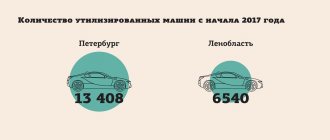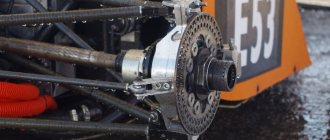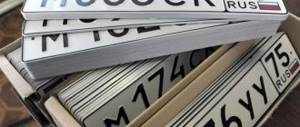Recycling fee concept
The tax payable upon purchasing a car was introduced in 2012. It is established by paragraph 1 of Article 24-1 of the Federal Law of June 24, 1998 (as amended on July 28, 2012) No. 89. It is a one-time payment paid by car buyers. The money is sent to the country's budget. It is assumed that they will be used for environmental needs. In particular, for car recycling, which is required to maintain a favorable environmental situation.
The fee is paid in accordance with paragraph 3 of Article 24-1 of Federal Law No. 89 under these circumstances:
- When importing a vehicle from another state.
- When purchasing a vehicle from a person who has not paid the recycling fee for various reasons: exemption from payments, dishonesty.
The fee must be paid either by the vehicle manufacturer or the buyer.
Who can avoid paying the recycling fee?
Let's consider the circumstances under which a person is exempt from paying the fee:
- The service life of the car is more than 30 years. At the same time, exemption from the fee is relevant only if the following circumstances are met: the car is not used for commercial purposes, spare parts (body, engine) for the vehicle are original.
- The vehicle belongs to diplomatic missions, consulates, and international structures. Exemption from fees applies to all employees of these entities.
- The vehicle is imported into the Russian Federation as personal property by people participating in the program for relocating Russians from abroad.
IMPORTANT! If representatives of the last two categories sell cars, the DC is paid by the buyers of the vehicle.
Recycling fee in 2021: what's new?
As of 04/01/2018, the list of wheeled vehicles and trailers for which a recycling fee is paid has been updated.
Who pays the recycling fee?
Recycling fees are paid for wheeled vehicles, chassis and trailers in the following cases:
- importing them into the Russian Federation,
- production or manufacturing in the Russian Federation,
- purchasing them from persons who have not paid the recycling fee for preferential import or illegally,
with the exception of vehicles specified in paragraph 6 of Article 24.1 of the Federal Law of June 24, 1998 No. 89-FZ “On Production and Consumption Waste”, namely:
- vehicles imported into the Russian Federation as personal property by individuals who are participants in the State Program to Assist the Voluntary Resettlement of Compatriots Living Abroad to the Russian Federation, or who are duly recognized as refugees or forced migrants;
- vehicles imported into the Russian Federation and belonging to diplomatic missions or consular offices, international organizations enjoying privileges and immunities in accordance with generally recognized principles and norms of international law, as well as employees of such missions, institutions, organizations and members of their families;
- Vehicles that are thirty or more years old, are not used for commercial purposes, have the original engine, body and (if available) frame, and have been preserved or restored to original condition.
The list of types and categories of vehicles in respect of which a recycling fee is paid is established for wheeled vehicles (chassis) and trailers for them by Decree of the Government of the Russian Federation dated December 26, 2013 No. 1291 (hereinafter referred to as List No. 1291).
How to calculate the recycling fee
The recycling fee should be calculated independently - as the product of the base rate and a special coefficient (clause 5 of the Rules for the collection, calculation, payment and collection of the recycling fee in relation to wheeled vehicles (chassis) and trailers for them, as well as the return and offset of overpaid or overcharged amounts of this fee approved by Decree of the Government of the Russian Federation dated December 26, 2013 No. 1291, hereinafter referred to as Rules No. 1291).
There are two base rate values:
20,000 rub. – for wheeled vehicles of category M1, including all-terrain vehicles of category G, as well as for special and specialized vehicles of this category;
150,000 rub. - For:
- wheeled vehicles of categories M2, M3, N1, N2, N3, including all-terrain vehicles of category G, as well as specialized vehicles of these categories;
- chassis of wheeled vehicles of categories N1, N2, N3, M2, M3;
- trailers for wheeled vehicles.
Special coefficients for wheeled vehicles and their trailers are established depending on the weight and engine volume.
What has changed and for whom?
Economic entities producing (manufacturing) in the Russian Federation vehicles from List No. 1291, as well as purchasing them from persons who have not paid the recycling fee, are required to report the recycling fee to the tax inspectorate (clause 4 of the Rules of Rule No. 1291). In this regard, it is important to pay attention to the changes made by the commented resolution from 04/01/2018 to List No. 1291.
1. Special coefficients have been increased in relation to vehicles (chassis) and trailers for them included in List No. 1291.
2. New names of vehicles are included in List No. 1291:
- truck tractors with a gross weight of over 12 tons, but not more than 20 tons;
- truck tractors with a gross weight of over 20 tons, but not more than 50 tons.
You must pay the recycling fee for these vehicles from 04/01/2018. Moreover, when importing them into Russia and placing them under the customs regime of temporary import in accordance with Decree of the Government of the Russian Federation dated March 11, 2003 No. 147, the recycling fee is calculated with a coefficient of 0.25.
3. For the period until December 31, 2018, special coefficients have been established separately for vehicles manufactured on the basis of the 2021 chassis.
4. Special coefficients have been differentiated for trailers - full, semi-trailers, trailers with a central axle.
In conclusion…
Calculation of the amount of the recycling fee in the form approved by order of the Federal Tax Service of Russia dated October 24, 2016 No. ММВ-7-3/ [email protected] must be submitted to the tax office at the location of the organization or its separate division after three working days from the date of payment of the recycling fee . Along with the payment, vehicle passports and other documents specified in clause 16 of Regulation No. 1291 must be presented.
How is the recycling fee calculated?
The DC is calculated using this formula:
CS = BS * K
Where:
- US – fee amount;
- BS – base rate;
- K is the coefficient used, which is determined on the basis of the List of CM sizes established by Government Decree No. 81 dated 02/06/2016.
There are only two bets:
- 20 thousand rubles for passenger cars that are not used in commercial activities.
- 150 thousand rubles for trucks, buses, as well as passenger vehicles that are used in commercial activities.
The coefficients are set by law. There are many of them, and they are determined based on the following factors:
- Dimensions.
- Weight.
- Engine capacity.
For example, the coefficient for a passenger car older than three years weighing less than 2.5 tons will be 0.88. This is the value that will be used in the calculations.
Calculation example
An imported bulldozer (weighing no more than 10 tons) with a service life of less than 3 years was purchased. The base rate will be 150,000 rubles, since special equipment will be used for commercial purposes. The coefficient for a car of the type in question is 4. The following calculations are made:
150,000 * 4 = 600,000 rubles.
This is the amount that will need to be paid when importing a car of the type in question from abroad.
The recycling fee on front-end forklifts is a welcome change.
On July 23, 2021, Decree of the Government of the Russian Federation dated July 11, 2019 No. 884 “On amendments to certain acts of the Government of the Russian Federation” came into force. This resolution of the Government of the Russian Federation amended the Decree of the Government of the Russian Federation dated 02/06/2016 No. 81 “On the recycling fee in relation to self-propelled vehicles and (or) trailers for them and on amendments to certain acts of the Government of the Russian Federation”, thereby establishing a number of sections of the list in the new edition types and categories of self-propelled vehicles and trailers for them, in respect of which a recycling fee is paid.
- Section VI is specified. The list of “Front loaders” by including forklifts in it;
- in section XI. The list of “Machinery and equipment for forestry”, with an accuracy of up to 10 characters of the EAEU Commodity Nomenclature for Foreign Economic Activity, defines the types and categories of self-propelled machines belonging to this section;
- Self-propelled vehicles (for example, stackers) with a power plant power of less than 5.5 hp and controlled by a nearby driver (operator) are exempt from paying the recycling fee;
- other changes affecting not only self-propelled equipment, but also vehicles.
These innovations apply to legal relations that arose from June 13, 2018.
GOVERNMENT OF THE RUSSIAN FEDERATION
DECISION of July 11, 2021 N 884
ON AMENDMENTS TO SOME ACTS OF THE GOVERNMENT OF THE RUSSIAN FEDERATION
The Government of the Russian Federation decides:
- Approve the attached changes that are being made to the acts of the Government of the Russian Federation.
- The effect of paragraphs four and five of subparagraph "c", paragraphs of the second - seventh subparagraph "f", subparagraph "g" of paragraph 2 of the amendments approved by this resolution applies to legal relations arising from June 13, 2021.
Chairman of the Government of the Russian Federation D. MEDVEDEV
Approved by Decree of the Government of the Russian Federation dated July 11, 2021 N 884
CHANGES THAT ARE MADE TO THE ACTS OF THE GOVERNMENT OF THE RUSSIAN FEDERATION
- In the list of types and categories of wheeled vehicles (chassis) and trailers for them, in respect of which a recycling fee is paid, as well as the size of the recycling fee, approved by Decree of the Government of the Russian Federation of December 26, 2013 N 1291 “On the recycling fee in relation to wheeled vehicles means (chassis) and trailers for them and on amendments to certain acts of the Government of the Russian Federation" (Collection of Legislation of the Russian Federation, 2014, No. 2, Art. 115; 2021, No. 13, Art. 1817), the name of section VI is stated in the following edition:
“VI. Trailers put into circulation on the territory of the Russian Federation, category O4, including special and specialized vehicles of the specified categories <7>, <8>.” - In the list of types and categories of self-propelled vehicles and trailers for them, in respect of which a recycling fee is paid, as well as the size of the recycling fee, approved by Decree of the Government of the Russian Federation of February 6, 2021 N 81 “On the recycling fee in relation to self-propelled vehicles and (or) trailers for them and on amendments to certain acts of the Government of the Russian Federation" (Collected Legislation of the Russian Federation, 2021, No. 7, Art. 991; 2021, No. 24, Art. 3528):
- The title of section I should be stated as follows:
“I. Graders and planners (classified by codes 8429 20 001 0, 8429 20 009 1, 8429 20 009 9) <6>"; - The title of section V should be stated as follows:
“V. Tamping machines and road rollers (classified by codes 8429 40 100 0, 8429 40 300 0, 8429 40 900 0) <6>"; - in section VI: the title should be stated as follows:
"VI. Front-end and fork loaders (classified by codes 8427 10, 8427 20, 8429 51) <6>";line F01 should be worded as follows:
“F01 with a power plant capacity of at least 5.5 hp. and less than 50 hp 16";
- the title of section VIII should be stated as follows:
“VIII. Pipe-laying cranes, crawler cranes (classified by codes 8426 49 001 0, 8426 49 009 1, 8426 49 009 9) <6>"; - section IX shall be stated as follows:
“IX. Trailers (classified by codes 8716 20 000 0, 8716 31 000 0, 8716 39 500 1, 8716 39 500 9, 8716 39 800 5, 8716 39 800 8, 8716 40 000 0, 8716 39 1 00 0, 8716 39 300 9) <6> H01 trailers with a load capacity of more than 10 tons 1 7 H02 semi-trailers with a load capacity of more than 10 tons 1 7"; - in section XI: line J01 should be worded as follows: “J01 with a power plant capacity of at least 20 hp. and less than 100 hp 8 50";
line J04 should be worded as follows: “J04 with a power plant capacity of at least 20 hp. and less than 100 hp 8 50";line J07 should be worded as follows: “J07 with a power plant capacity of at least 20 hp. and less than 100 hp 8 10";
- line M01 of section XIV should be amended as follows:
- in footnote 3, replace the word trailer in the appropriate case with the words “trailer (semi-trailer)” in the appropriate case;
- footnote 6 should be supplemented with the following paragraph:
name of the subsection “Front-end timber loaders and skidders (skidders) for forestry (classified by codes 8427 20 190, 8427 90 000, 8701 94 100 1, 8701 94 100 9, 8701 94 500 0, 8701 95 100 1, 8701 95 500 0) <6>" shall be stated as follows: "Front-end timber loaders and skidders (skidders) for forestry (classified by codes 8427 20 190 1, 8427 20 190 2, 8427 90 000, 8701 94 100 1, 8701 94 100 9, 8701 94 500 0, 8701 95 100 1, 8701 95 500 0) <6>";
“M01 with a power plant capacity of more than 5.5 hp. and no more than 30 hp. 0.4 1.8";
“For the purpose of implementing this resolution, self-propelled vehicles are not recognized as vehicles with a power plant power of less than 5.5 hp, controlled by a nearby driver (operator).”
Where should I pay the tax when importing a car from abroad?
If the payment is made when importing a car from another state, the funds are collected by the Federal Customs Service. Payments must be made within the customs clearance period. You will also need to pay a recycling fee. In order to do all this, you need to come to the customs office at your place of residence. You need to take the following documents with you:
- Recycling fee calculation form (must be completely completed).
- PTS for the car for which payments are made.
- Copies of papers that confirm the compliance of the machine’s characteristics with the data specified in the calculation (for example, a certificate of conformity, relevant expert opinions, accompanying documents).
- Vehicle purchase and sale agreement.
- Payment documents confirming payments.
- If a trusted person is involved in the procedure, a power of attorney will be required for him. After providing all these documents, specialists check the accuracy of the calculations performed, the authenticity of the papers, and payments to the FC account. After this, a mark is placed in the PTS about the payment of the recycling fee.
IMPORTANT! Bank details for transferring funds are posted on the FCS website.
Where should I pay the fee when purchasing a car without a mark in the title?
In the vast majority of cases, the recycling fee is paid by the manufacturer. The buyer transfers money only if he imports a car from abroad or the fee on the vehicle has not been paid by the previous owner. In the second case, payments are made to the Federal Tax Service. You need to go to the official website of the Federal Tax Service and find the appropriate section on fees. In it you can:
- Find out budget classification codes.
- Complete the calculation of the CS in the prescribed form.
- Make an appointment at your local Federal Tax Service.
Details for payment to the Federal Tax Service can also be found on the official website of the tax office. After payment of the fee has been made, you need to visit the tax office with these papers:
- US calculation form (completed).
- Title certificate for the car for which the fee is paid.
- Documents confirming the purchase of the car, and all other papers specified in the previous section.
FOR YOUR INFORMATION! The fee will also have to be paid to persons who assembled the car themselves. In this case, copies of the vehicle title that was used in the design of the new car are provided to the Federal Tax Service.
A note in the PTS about payment of the recycling fee
After payment of the fee, the corresponding mark is placed in the PTS. You need to pay attention to it both after making a payment and when purchasing a car. A mark is placed in the “special notes” section of the PTS. Differs in red color. Why is its presence so important? The mark indicates that the fee has been paid and there is no need to pay it again. She can only be absent if the following circumstances exist:
- PTS for a domestic car was issued before September 1, 2012.
- Imported cars were imported into the Russian Federation before September 1, 2012.
In both cases, no fee needs to be paid. For this reason, the absence of a mark should not be alarming.
Liability for non-payment of fees
Failure to pay the recycling fee in itself does not entail any sanctions. Even fines are not applied to violators. However, this does not mean that ignoring the law will go unpunished. A car that does not have a red mark on its title cannot be registered. In turn, for vehicles that are not registered (Article 12.1 of the Code of Administrative Offenses of the Russian Federation), a fine is imposed:
- 500-800 rubles – first violation.
- Up to 5,000 rubles or deprivation of a driver’s license for up to 3 months – repeated violations.
For this reason, it is more profitable to pay the fee.
Tax calculation for trucks
The recycling fee for cars 2021 and the procedure for calculating it are made using a simple formula. The coefficient established by the relevant Government Decree is decisive for the final amount. For the year 2018, this calculation is based on their Resolution No. 300 dated March 19, 2018. It is uniform for the entire country and is classified by car brand. The final total payable is determined as the product of the established coefficient and the base rate. At the same time, each type of car has its own coefficient depending on the engine size, load capacity, and age of the car.
For example:
- Vans and vehicles designed for 20-50 tons, up to 3 years old, have a coefficient of 5.5. With a base rate of 150,000 rubles. the fee amount looks like this: 150,000 * 5.5 = 825,000 rubles.
- For dump trucks with a carrying capacity of 12 to 20 tons, the fee payable is between 418,000 and 1,735,500.
- Vehicles designed for cargo less than 2.5 tons are subject to a fee of 142,500 rubles. (new and up to 3 years) and 151,500 rubles. (from 3 years and older).
Similar articles
- New recycling fee 2018
- Increase in recycling fee 2018
- Recycling fee for ATVs 2018
- Recycling fee for semi-trailers
- Special notes in the PTS - recycling fee
What should I do if the fee is paid in a larger amount?
In this case, a request for a refund will be left. It is sent to the authority where the tax was paid. In addition to the document, you must provide the following documents:
- Payment documents evidencing payment of the fee.
- Confirmation that the fee was paid in excess (for example, the difference between the calculation carried out and the amount indicated in the payment order).
- The application is reviewed within a month. After this, a decision is made. If the authorized body refuses to return, the refusal must be justified.
ATTENTION! You can apply for a refund of the overpaid amount within three years from the date of payment. However, this is best done faster, since the funds are not indexed. That is, after three years they will be issued in the same amount as they were paid. It is very likely that inflation will “eat up” a large amount of money.
Most legal entities and individuals do not face the need to pay the tax. However, if it does occur, you need to figure out the order in which funds are transferred. There are many nuances. In some circumstances, funds are transferred to one authorized body, in others - to another. After making payments, you must save the payment document. He will confirm the fact and amount of payment, if required.










